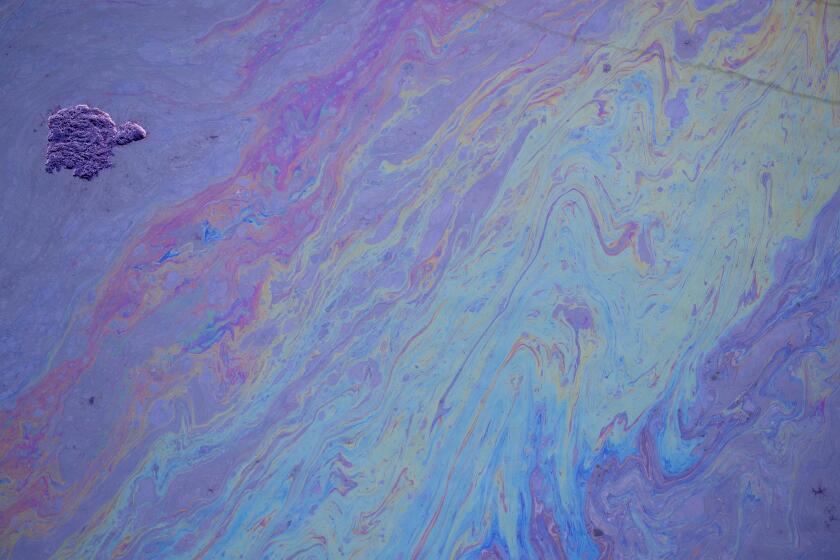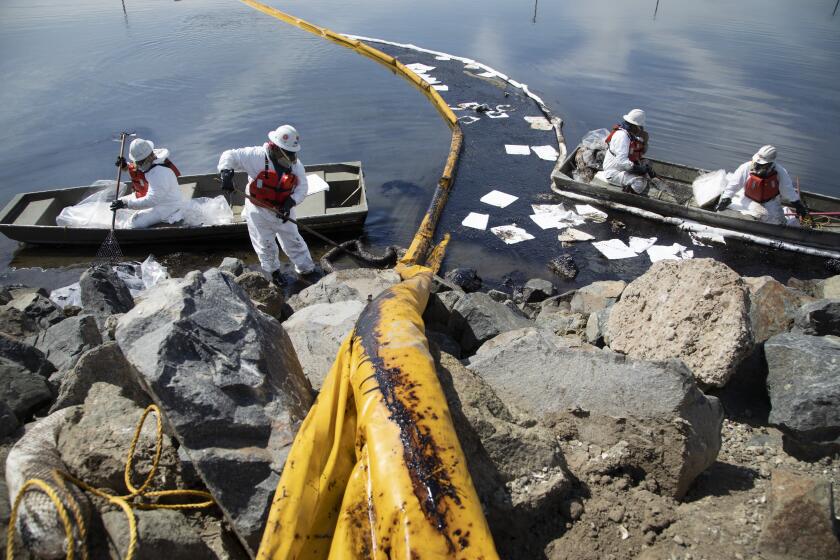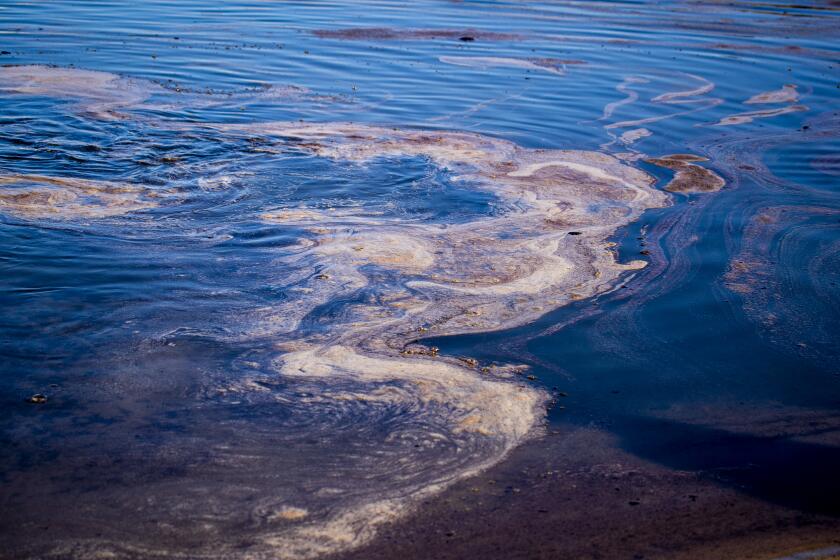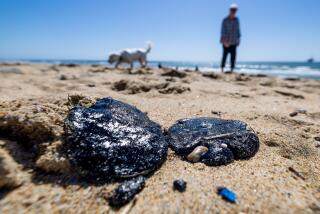Officials declare O.C. oil spill cleanup complete
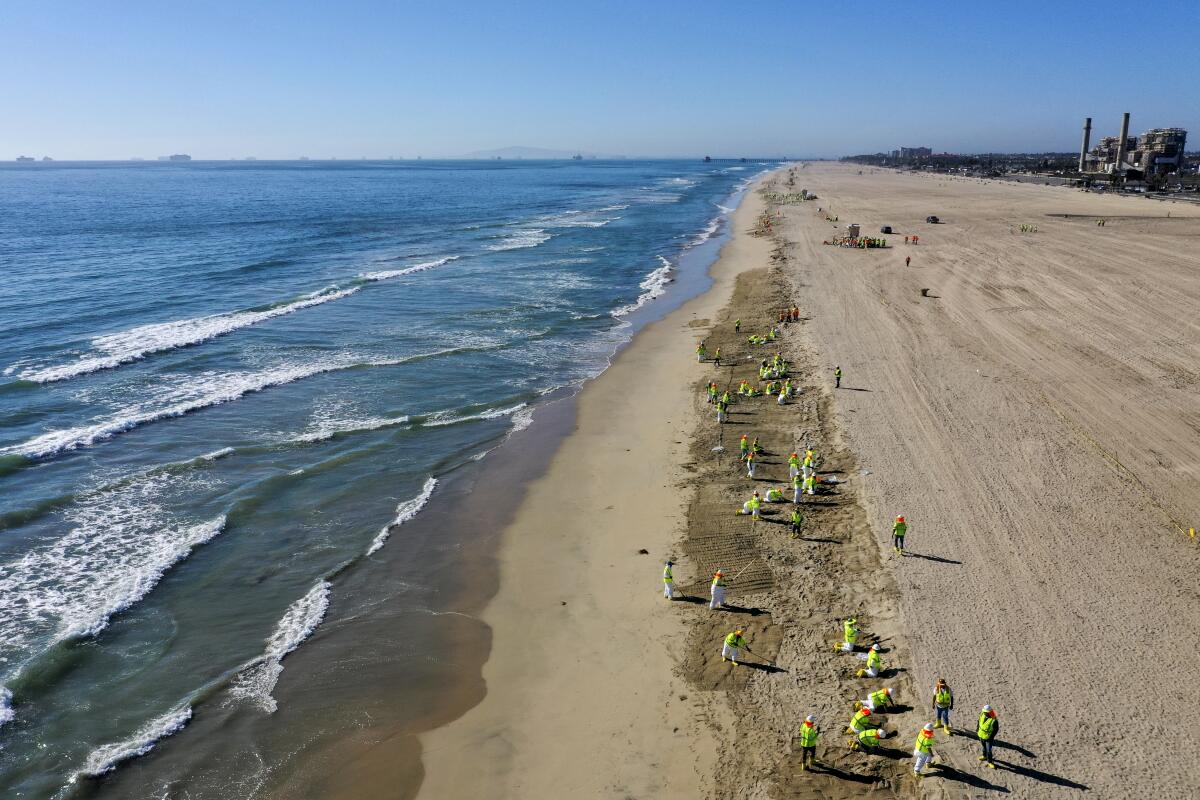
- Share via
Nearly three months after an undersea pipeline spilled thousands of gallons of crude oil into the waters off Southern California, authorities have announced that coastal cleanup efforts are now complete.
“After sustained cleanup operations for the Southern California oil spill, affected shoreline segments have been returned to their original condition,” officials said in a news release Tuesday. The unified command cleanup response was led by the U.S. Coast Guard, the California Department of Fish and Wildlife’s office of oil spill prevention and response, and Orange and San Diego counties.
Authorities were first alerted to the possibility of an oil spill off Orange County on Friday, Oct. 1. Residents noticed a sheen that Saturday, and by sunrise the following morning, a diesel-like odor had overtaken the area as an oil slick neared Huntington Beach. Crashing waves brought dark crude onto the shore, along with dead birds and fish.
Response teams mobilized quickly, including biologists and environmentalists who scrambled to put barriers between the oil and Talbert Marsh, a 25-acre ecological reserve that is home to dozens of species. Gov. Gavin Newsom declared a state of emergency in Orange County.
“In a year that has been filled with incredibly challenging issues, this oil spill constitutes one of the most devastating situations that our community has dealt with in decades,” Huntington Beach Mayor Kim Carr said at the time.
An oil slick believed to have originated from a pipeline leak has hit Huntington Beach, closing a stretch of beach and raising grave wildlife and environmental concerns.
The spill sparked a statewide conversation about fossil fuel reliance and also renewed calls for the government to take more aggressive action against the aging oil platforms that dot the state’s coast.
Orange County Supervisor Katrina Foley, whose district includes Huntington Beach, said Wednesday it was “great to have the cleanup component of this behind us,” but that there is still much work to be done.
“The first thing that we’ve learned is that this aging infrastructure is decomposing and is not being well-maintained, and that has to be addressed immediately,” Foley said. “The second most important lesson is that there is a galvanization of community support to decommission these rigs, so long as we are able to transfer those ‘dirty energy’ jobs to ‘clean energy’ jobs and take care of the workers.”
Foley said the spill’s effects rippled through the coastal community — from local fisheries and surf schools that lost business, to damaged properties and canceled events, including the Pacific Airshow that had been scheduled that weekend.
“There was, I think, a dramatic understanding by those who might not have been so aligned with the environmentalists as to the impacts of offshore oil drilling,” she said. “It’s impactful to the economy, impactful to the environment, to the coast — to our lives in general. I think all those factors combining together really hit people hard this time, more so than in the past.”
Even beyond climate change, there are many reasons to transition to solar and wind power — the Huntington Beach oil spill among them.
The 25,000-gallon spill was quickly linked to an oil processing platform called Elly, which stands roughly nine miles from shore, in federal waters.
In the days and weeks that followed, Elly’s operator, Amplify Energy Corp., fell under increasing scrutiny for a 15-hour delay in notifying federal regulators about the spill.
Coast guard investigators say a dragging anchor may have damaged the 17-mile pipeline that runs from Elly to a terminal in Long Beach, although the exact cause of the spill remains unclear.
Earlier this month, a federal grand jury indicted Amplify Energy and two subsidiaries on criminal charges for their alleged role in the spill.
Amplify has also participated in the cleanup effort.
“This response was a true team effort — one that included the commitment and dedication of federal, state and local agencies along with our response team,” read a statement from Dan Steward, vice president of Amplify Energy’s Beta operations. “We are grateful for their work and would like to thank all the members of the Unified Command for their professionalism and collaboration over the past three months.”
The pipeline remains shut down, officials said. Representatives from the Pipeline Hazardous Material Safety Administration, the Bureau of Safety and Environmental Enforcement and the state fire marshal are overseeing flushing operations to remove the remaining oil from the line.
Meanwhile, multiple lawsuits and civil claims are making their way through the court system. Foley said the county’s claims for cleanup efforts alone amount to more than $1 million.
A federal grand jury accused Amplify Energy Corp. and two subsidiary firms of illegally discharging oil from a pipeline they operated off Huntington Beach.
The oil also impacted wildlife. In the wake of the spill, veterinary officials at the UC Davis Oiled Wildlife Care Network reported 82 dead birds, three dead sea lions and a dead bottlenose dolphin, among other impacted animals.
Debbie McGuire, executive director of the Wetlands and Wildlife Care Center in Huntington Beach, was among the network members to respond.
“I was pretty stressed out. I was pretty scared,” she said Wednesday, noting that the group is still watching for potential victims even though the cleanup has been declared complete.
While birds tend to get sick right away — the oil ruins their waterproofing and leaves them susceptible to cold and hypothermia — marine mammals can have chronic problems that show up later, she said.
And though the spill ended up being smaller than officials feared — it was initially estimated to be 126,000 gallons — McGuire said it was a distressing reminder of the precariousness of oil production in California. The group also responded to the Refugio oil spill in Santa Barbara in 2015 and the American Trader oil spill in 1990.
“Jump forward 31 years, and we have another oil spill,” she said, adding: “Everyone should probably take a good look and think about how safe it is to have those drilling platforms.”
Yet another oil sheen was spotted in the area in November and was quickly contained.
The oil spill had reached the Talbert Marsh and some environmentally sensitive wetlands areas by Sunday morning.
Foley said one positive takeaway from the spill was that it became a “great model for how public agencies at the federal, state and local level can partner together, including partnering with local business and residents.”
She also said it drove home the effects of offshore oil drilling, both economic and environmental.
It’s time to “get moving on that [transition] process in a way that’s thoughtful, but is planning for a future for California that does not include oil rigs off the coast,” she said.
Christian Corbo, the patrol lieutenant with the California Department of Fish and Wildlife who served as the state’s on-scene coordinator, expressed gratitude to the hundreds of responders who “rushed in with their experience and expertise early on and remained committed over the course of the response.”
“We are grateful to all the dedicated scientists, wildlife care experts, technical specialists and law enforcement personnel who commit themselves to protecting our natural resources,” Corbo said in a statement.
The Department of Fish and Wildlife in November determined it was safe to eat seafood taken from the waters, and fishing operations off Orange County have resumed.
U.S. Coast Guard Captain Rebecca Ore, the incident’s federal on-scene coordinator, echoed Corbo’s sentiment.
“The collaborative efforts of the first responders, public safety professionals, assessment teams and response workers were critical to ensure our waters, beaches and wildlife were cleaned to the highest standard,” she said, noting that the response included more than 1,800 personnel.
Officials said the oiled sand and debris are being disposed of in a special landfill designed for petroleum-contaminated material.
The spill response will now enter a “transition period” in which the unified command will monitor for incidents of tar balls and oil, and analyze any findings to determine their source.
Members of the public are asked to report any sizable sightings of oil or oily debris to the National Response Center at 1-800-424-8802.
Once the unified command team determines that the transition period is over, the oil spill response will officially conclude.
More to Read
Sign up for Essential California
The most important California stories and recommendations in your inbox every morning.
You may occasionally receive promotional content from the Los Angeles Times.

